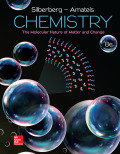
Concept explainers
Interpretation:
The volume of gaseous iodine pentafluoride measured
Concept introduction:
Ideal gas law equation is as follows:
Here,
Rearrange equation (1) for
Conversion factor to convert
The conversion factor to convert
When the number of each atom in the reactant side is equal toa number of each atom in the product side then the reaction is known as a balanced chemical reaction. The reactant present in the lower quantity of moles is the limiting reagent.
Answer to Problem 5.13BFP
The volume of gaseous iodine pentafluoride measured
Explanation of Solution
The value of the universal gas constant
The pressure of fluorine gas
The volume
The weight of iodine gas is
The molecular weight of
The value of the temperature of fluorine gas is
The value of the temperature of
Substitute  in equation (3) to calculate the temperature in Kelvin.
in equation (3) to calculate the temperature in Kelvin.
Substitute  in equation (3) to calculate the temperature in Kelvin.
in equation (3) to calculate the temperature in Kelvin.
The balanced chemical equation for the given reaction is as follows:
Substitute
According to the balanced chemical equation, the stoichiometric ratio between
The formula to calculate the number of moles of
Substitute
According to the balanced chemical equation, the stoichiometric ratio between
The formula to calculate the number of moles of
Substitute
The amount of
Rearrange equation (2) for the volume of
Substitute
The volume of gaseous iodine pentafluoride measured
Want to see more full solutions like this?
Chapter 5 Solutions
EBK CHEMISTRY: THE MOLECULAR NATURE OF
 ChemistryChemistryISBN:9781305957404Author:Steven S. Zumdahl, Susan A. Zumdahl, Donald J. DeCostePublisher:Cengage Learning
ChemistryChemistryISBN:9781305957404Author:Steven S. Zumdahl, Susan A. Zumdahl, Donald J. DeCostePublisher:Cengage Learning ChemistryChemistryISBN:9781259911156Author:Raymond Chang Dr., Jason Overby ProfessorPublisher:McGraw-Hill Education
ChemistryChemistryISBN:9781259911156Author:Raymond Chang Dr., Jason Overby ProfessorPublisher:McGraw-Hill Education Principles of Instrumental AnalysisChemistryISBN:9781305577213Author:Douglas A. Skoog, F. James Holler, Stanley R. CrouchPublisher:Cengage Learning
Principles of Instrumental AnalysisChemistryISBN:9781305577213Author:Douglas A. Skoog, F. James Holler, Stanley R. CrouchPublisher:Cengage Learning Organic ChemistryChemistryISBN:9780078021558Author:Janice Gorzynski Smith Dr.Publisher:McGraw-Hill Education
Organic ChemistryChemistryISBN:9780078021558Author:Janice Gorzynski Smith Dr.Publisher:McGraw-Hill Education Chemistry: Principles and ReactionsChemistryISBN:9781305079373Author:William L. Masterton, Cecile N. HurleyPublisher:Cengage Learning
Chemistry: Principles and ReactionsChemistryISBN:9781305079373Author:William L. Masterton, Cecile N. HurleyPublisher:Cengage Learning Elementary Principles of Chemical Processes, Bind...ChemistryISBN:9781118431221Author:Richard M. Felder, Ronald W. Rousseau, Lisa G. BullardPublisher:WILEY
Elementary Principles of Chemical Processes, Bind...ChemistryISBN:9781118431221Author:Richard M. Felder, Ronald W. Rousseau, Lisa G. BullardPublisher:WILEY





